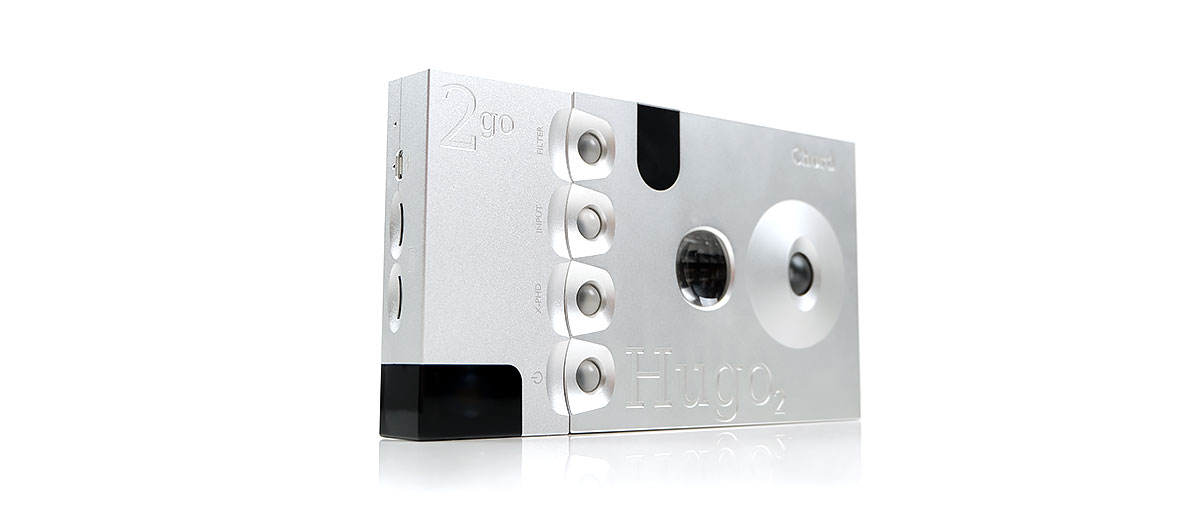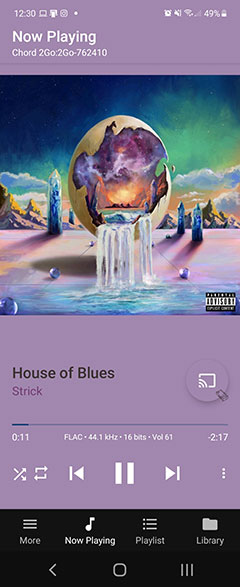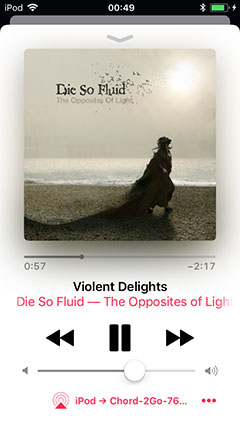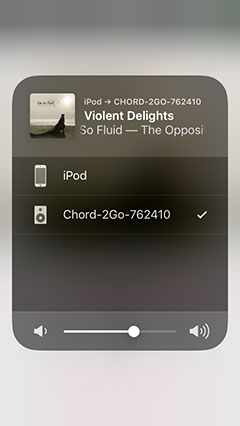Performance
To get an in-depth review of the core presentation of the Hugo 2 please click here for our original review. The 2go will tweak here and there in terms of performance but the timbre is largely unchanged. We also could not test the Ethernet performance as our office is not set up for ethernet audio.
WiFi
If you plan to go wireless with the 2go then using the WiFi option will give you a vastly superior performance in terms of streaming audio quality and range compared to BT. You will get a massive boost in the stable distance from the source over Bluetooth with the only “x-factor” being your own modem’s capability.
The 2.4Ghz WiFi connection gave us a ton of additional distance with the Hugo 2/2go combo. There was no dropout behind up to 2 walls and possibly close to 20-25m depending on where your router is located.
In terms of receiving a stable buffered signal via WiFi, this might depend on the amount of data being sent, i.e. bit and sample rate of the file, be it locally on the network via DLNA or via a streaming net service.
As mentioned, every router is different and every outcome may well be unique for every 2go owner. For example, on our own route combined with a TPLink Deco M5, there were zero issues streaming at 16BIT/44.1k and 24BIT/48k as well as first stage software unfolding via TIDAL to receive 24BIT/96k in FLAC.
However, higher resolution files at either DSD64 or 24BIT/192kHz PCM or above were less successful which may indicate a bottleneck somewhere in our modem or 2go’s streaming channel bandwidth as a receiver.
Bluetooth
If you are using it with the Hugo 2, the amp/DAC’s own BT option is more capable with up to aptX decoding compared to just SBC/AAC if using the 2go.
If you have the 2go bolted onto the Hugo 2 you turn off the 2go manually to activate the Hugo 2 Bluetooth option and pair as normal. If you have the 2go turned on the Hugo 2 BT module will be deactivated.
A2DP is miles behind WiFi in terms of both stability and audio quality and it shows if you try to stream from your smartphone to the 2go using Bluetooth only with a far more limited range and higher rates of dropout once you get close to the edge of that range.
Bluetooth audio via 2go is also a considerable drop in dynamic range and resolution compared to the WiFi lossless equivalent. Audio quality was also fairly poor with a very compressed sound from the likes of Qobuz via a Samsung Z Flip 3. Staging narrowed considerably and details simply got lost in that flat delivery.
Of course, the one benefit is the potentially enhanced WiFi stability from the modem to the receiver if you are using BT transmission from the receiver to the 2go. Especially if your receiver such as a smartphone can handle 5Ghz.
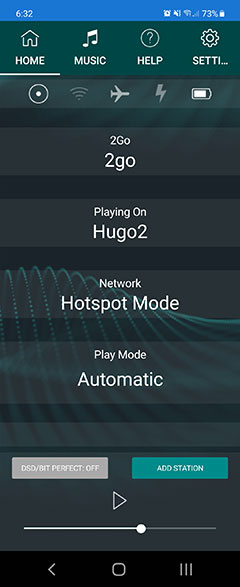
WiFi Hotspot
If you plan on streaming from microSD cards then I recommend using 2go as a media server via its WiFi hotspot mode rather than a BT connection from a source.
Especially so if you plan on playing some seriously hi-res tracks which the 2go WiFi Hot Spot mode combined with a smartphone BubbleUPnP remote control point handles with aplomb.
Technically you are not really streaming using this setup with the 2go acting primarily as a transport. You are simply accessing the stored media via a UPnP control point such as Hi-Fi Cast, mconnect, BubbleUPnP, and asking 2go to send the signal to the Hugo 2 DAC via its micro-USB connection.
This is probably the simplest and best sounding aspect of the Hugo 2/2go partnership but then I expected that from my time with the Poly/Mojo which does much the same thing. Wired/WiFi hybrid it may be but an enclosed signal with far less to worry about in terms of traditional wired PC USB-DAC connection issues from such as jitter and noise.
Synergy
Apps integration is where the value add is with the 2go and it does seem Chord has fined tuned the service even better than was the case with the Poly/Mojo combo with Roon Ready and the auto-switching seamless integration between Roon, DLNA, and various other net-based streaming services.
With Roon/TIDAL integration, AirPlay and DLNA you do have most of the bases covered here without having to manually select between Roon and DLNA as was the case with the Poly.
Roon
Probably my go-to these days for streaming both local files and 3rd party services such as TIDAL. Like the Poly, the 2go is Roon Ready which basically means it will work out of the box with a Roon core and be seen also by any official Roon remote, for example, Roon on Android.
My own experience with Roon and the 2go experience mirrored my previous Poly review with a very smooth streaming service up to 24BIT/48kHz and at times some 96kHz tracks.
However, our router to 2go streaming limitation with hi-res files quickly showed up with tracks up to 192Khz not buffering as well and timing out with the ‘slow loading experience’ warning.
The second point is the lack of MQA support with TIDAL integration which means an initial software unfolding and nothing beyond. Chord does not support MQA anyhow and none of their products offer any MQA unfolding.
Roon Sound Quality
The sound quality from Roon local library streaming is just a tiny bit behind the WiFi hotspot microSD card experience but still very impressive. There is just a slightly more open sound to my ear and a blacker background from the memory card-loaded tracks.
Tiny little nuanced details and spatial cues were easier to pick up from the microSD card stored tracks which can often make the difference with high-end monitors.
3rd Party will depend more on the bit and sample rate being delivered but even at 16BIT/44.1kHz, it’s all Hugo 2 reference level accuracy and a smooth but linear sounding coloration with excellent detail.
You do get access to Roon’s excellent DSP functions including PMEQ which makes pairing with IEMs and headphones even easier with the Hugo 2.
DLNA
The DLNA compatibility is excellent with every single DLNA server and 3rd party app interface such as mconnect and Hi-Fi Cast are able to activate the 2go as a renderer for about 80% of my networked library without stutter or timeouts.
The 20% that does not stream so well is at DSD level or 24BIT/192kHz which I place partial blame on our router’s limited data headroom.
Of course, you can opt for an audio conversion process to ease the streaming process of those files, something which JRiver’s Media Center client networking options can do but this will result in a lossy format delivery.
This is also the way to go to access TIDAL and Qobuz if you do not have Roon which can be fairly expensive. Apps like BubbleUPnP will allow you to log in to these services and pull the environment right into their app framework and from there you can stream to 2go.
Routing external streaming in this manner is not as intuitive or as aesthetically attractive as Casting direct from the apps themselves but the performance is just as good when the streaming is smooth.
Airplay
I don’t use iOS platforms much except to test devices during the review process but pairing with 2go via Airplay is a lot simpler to implement than DLNA or Roon for non-tech heads.
You can use it in either 2go’s hotspot mode or any shared WiFi network connection with any Apple product with the Airplay feature, in my case an old iTouch 6th gen.
Simply load up your music library via your chosen app then look for the AirPlay icon at the bottom of the screen and then select the 2go for audio output. It should switch right away and start streaming to the 2go/Hugo 2 combo. If you have used Google’s Cast service it works a bit like that.
The audio performance was good though not to the level of the 2go’s excellent WiFi Hotspot level for local file playback. I would recommend you use FlacBox or Vox apps and load up some higher quality FLAC and AirPlay from there instead of the regular Apple music player. Compressed AAC tracks over WiFi are not a patch on FLAC lossless alternatives if you plan on using the Hugo 2.
Click on page 3 below for select comparisons

